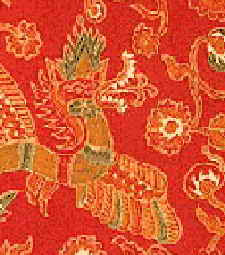
Kamis, 01 Oktober 2009
MOTIF BATIK KUNO

BATIK DRAGON MOTIFS DESIGN
BATIK TULIS HOKOKAI FROM JAVA

BATIK CULTURE
Depending on the quality of the art work, dyes, and fabric, the finest batik tulis halus cloth can fetch several thousand dollars, reflecting the fact that it probably took several months to make. Batik tulis has both sides of the cloth ornamented. The Laweyan and Kauman areas in Surakarta, Indonesia are famous for fine batiks.[citation needed] On the other hand batik cap and batik print are cheaper because it uses mechanical automation.
The Javanese aristocrats R.A. Kartini in kebaya and her husband in the 19th century.Her skirt is of batik, with the parang pattern which was for aristocrats
In Indonesia, traditionally, batik was sold in 2 1/4 meter lengths used for kain panjang or sarong for kebaya dress. It can also be worn by wrapping it around the body. Certain batik designs are reserved for brides and bridegrooms as well as their families. Other designs are reserved for the Sultan and his family or their attendants. A person's rank could be determined by the pattern of the batik he/she wore. For special occasions, batik was formerly decorated with gold leaf or dust. This cloth is known as prada (the Javanese word for gold) cloth. Gold decorated cloth is still made today; however, gold paint has replaced gold dust and leaf.
Tari Merak, Sundanese traditional peacock dance.The batik is wrapped around the body
Contemporary batik, while owing much to the past, is markedly different from the more traditional and formal styles. For example, the artist may use etching, discharge dyeing, stencils, different tools for waxing and dyeing, wax recipes with different resist values and work with silk, cotton, wool, leather, paper or even wood and ceramics.
In Indonesia, batik popularity has its up and downs. Historically it was a part of ceremonial costumes and it was worn as part of a kebaya dress, which was widely used everyday. It waned during the 1960s till 1990s, because more and more women wore western clothes instead. Although its use where heavily incorporated in formal occasions especially in the Javanese royal occasions, the batik continued to wane in everyday lives of the general populace. It reached a new revival in the 2000s with the effort of the Indonesian fashion designers, to revive batik and the kebaya altogether, they incorporate new colors, fabrics and patterns. Batik has become part of a fashion for young people in Indonesia, for casual wear it is normally worn as a shirt,dress or scarf. For a formal occasion, women normally wears it as part of a kebaya. It is also acceptable to wear batik for office attire, it must be noted the kebaya is not an office attire and men wear the batik only as a shirt to the office.
Batik has found worldwide popularity. Nelson Mandela wears a batik shirt on formal occasions, the South Africans call it a Madiba shirt. The Malaysian singer Siti Nurhaliza wore an Indonesian kebaya and batik on her wedding day. The late mother of United States president Barack Obama, Ann Dunham was an avid collector of Batik. In 2009, an exhibition of Dunham's textile batik art collection (A Lady Found a Culture in its Cloth: Barack Obama's Mother and Indonesian Batiks) toured six museums in the United States, finishing the tour at the Textile Museum.[7]. Batik is also worn in countries such as Malaysia, Singapore and southern Thailand, brought by the Indonesian immigrants to those countries in the 19th century. The flight attendants of Indonesian, Singaporean, and Malaysian national airlines all wear batiks for their uniform.
ETYMOLOGI OF BATIK
JAVANIS BATIK MOTIFS DESIGN
Batik (Javanese pronunciation:Indonesian pronunciation: English: batik or batik is cloth which traditionally uses a manual wax-resist dyeing technique. Due to modern advances in the textile industry, the term has been extended to include fabrics which incorporate traditional batik patterns even if they are not produced using the wax-resist dyeing techniques. Silk batik is especially popular.[citation needed]
Javanese traditional batik, especially from Yogyakarta and Surakarta, has special meanings rooted to the Javanese conceptualization of the universe. Traditional colours include indigo, dark brown, and white which represent the three major Hindu Gods (Brahma, Visnu, and Siva). This is related to the fact that natural dyes are only available in indigo and brown. Certain patterns can only be worn by nobility; traditionally, wider stripes or wavy lines of greater width indicated higher rank. Consequently, during Javanese ceremonies, one could determine the royal lineage of a person by the cloth he or she was wearing.
SIMPLE BATIK MOTIFS BUT ELEGAN
batik motifs designed with a simple and not so many variations of colors and motifs, but even so, batik has become a beautiful and elegant look when in use or in use to make clothes, and it is the power of batik can make a simple becomes extraordinary.

BATIK MOTIF BUNGA TULIP

UNIQUE DESIGN OF BATIK


